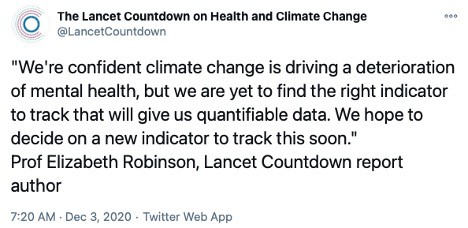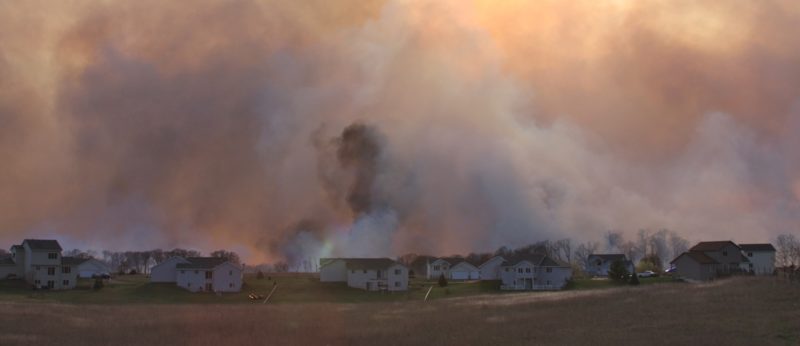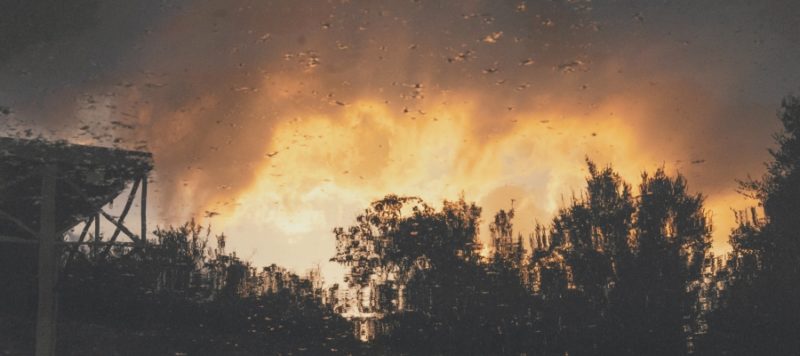THIS MONTH MARKED BOTH THE 5TH ANNIVERSARY OF THE PARIS AGREEMENT and the publication of the 2020 report of the Lancet Countdown on health and climate change. Every year since 2015, when countries formalized their commitment to limit global warming to “well below 2°C” as part of the Paris Agreement, the Countdown has measured progress toward the goals of the Agreement. The report presents 43 indicators to give a clear picture of the changes happening in the environment that affect global health, shining a light not just on direct climate impacts and exposures, but also on the economic costs and the work currently being done to help communities adapt, build resilience, and mitigate the health effects.
A staggering amount of work goes into each report and it is always worth a read. This year, a couple of things stood out to our team. While the Countdown has a strong track record of accounting for the intricate network of social, economic, political, community and individual factors that are affected by climate change and in turn affect health, the 2020 report goes extraordinarily deep in examining these underlying determinants. The report has a decided emphasis on the disproportionate impact on specific populations and raises critical questions about justice and the ways that climate change interacts with existing social and economic inequalities and acts as a “threat multiplier.”
Another thing that was striking was the very brief discussion of mental health—or rather, the authors’ acknowledgement that mental health was not included in the report in any meaningful way. Elizabeth Robinson, one of the authors of the Countdown, said in a tweet, “We’re confident climate change is driving a deterioration of mental health, but we are yet to find the right indicator to track that will give us quantifiable data. We hope to decide on a new indicator to track this soon.”
Given that the Countdown report is among the most comprehensive of its kind, the absence of mental health indicators is significant and needs to be addressed. David Eisenman, a practicing physician who also serves as the Deputy Director for Community Partnerships at C-Solutions, had this to say about the challenges of correlating climate change and mental health:
“It’s not enough to look at mental health symptoms or diagnoses since these are just the tip of the iceberg. So how do you capture the subtle, almost daily ways that climate change effects our mental well-being? For instance, the loss of nature and the solace it brings. Can we detect it and ascribe it to the slower, creeping changes occurring? What will be the mental health effects of blue skies that are lost due to chronic wildfire smoke like California had from August to November this year? And when this happens yearly how do we measure it?”
 One of the projects our research team at C-Solutions is working on looks at the mental health effects of surviving devastating wildfires. We focus on two dimensions of this problem. The first focus is on residents who return home to a devastated landscape and now have to deal with the financial and social stresses of rebuilding their homes and community. These residents are surrounded daily by visual reminders of their losses and the drastic changes that have occurred in their environment. The cumulative stress of this experience leads to solastalgia, a form of mental or existential distress caused by environmental change. It is associated with mental health distress in our work.
One of the projects our research team at C-Solutions is working on looks at the mental health effects of surviving devastating wildfires. We focus on two dimensions of this problem. The first focus is on residents who return home to a devastated landscape and now have to deal with the financial and social stresses of rebuilding their homes and community. These residents are surrounded daily by visual reminders of their losses and the drastic changes that have occurred in their environment. The cumulative stress of this experience leads to solastalgia, a form of mental or existential distress caused by environmental change. It is associated with mental health distress in our work.
The second focus of our work in this area is the mental health of non-traditional firefighters. These include residents who “stay to fight” and inmates, who were involved with wildfires as temporary, adjunct firefighters. These two populations had not chosen firefighting as a career and were not professionally trained in coping with lingering effects of trauma.
Scanning the literature, Eisenman says, “Frankly, there is very little empirical data on these topics. As far as community residents fighting fires, McCaffrey, Wilson and Konar reported an average 11.3% of community members stayed and defended their homes in a study of three counties in fire-prone areas across the US. But did they suffer any mental health effects from this stressor? A qualitative study of community resident firefighters in the Woolsey Fire centered in Malibu described their practical challenges but gave only the cursory statement that “trauma-related issues were apparent” among these community members. Not assessing their mental health status at the interview was a missed opportunity. As for the inmates: Inmates work and train as wildland firefighters in California’s prison fire camps. The literature describes this as simultaneously heroic, dignified work and a form of labor exploitation without health protections. Again, quantitative data is not available.”
We’re incredibly excited about Eisenman’s trailblazing work. However, wildfires are only one component of climate change. There is stronger evidence of the link between mental ill health and extreme weather events like hurricanes, but along with other disasters (heat waves, droughts, infectious disease outbreaks) and the slower manifestations of climate change (changing landscapes, increasing water and food insecurity), this area is still very much understudied. Engaging communities, policymakers, and other decisionmakers in the response to climate change requires that we understand the real harms that climate change inflicts on all of us. Mental health is an indispensable part of that understanding.








